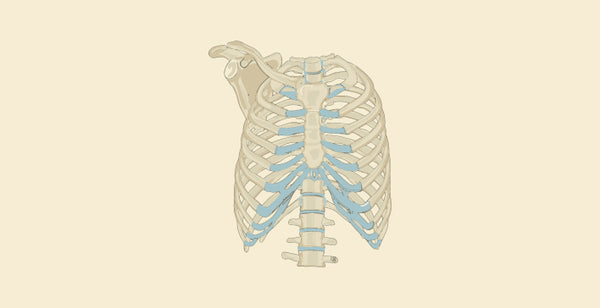Difference between Thoracic Cavity and Pulmonary Cavity: The Thoracic Cavity and Pulmonary Cavity are important anatomical components located within the chest of the human body. The Thoracic Cavity is a spacious chamber enclosed by the rib cage, vertebral column, and diaphragm, housing critical organs such as the heart, lungs, major blood vessels, oesophagus, thymus gland, and portions of the trachea. Whereas the Pulmonary Cavity is a precise space surrounding the lungs within the Thoracic Cavity. It encompasses the area between the visceral and parietal pleurae, which are thin layers of membrane enveloping each lung. This cavity contains a small amount of pleural fluid, facilitating smooth lung movement during respiration by reducing friction.
Difference between Thoracic Cavity and Pulmonary Cavity
The Thoracic Cavity encompasses important organs like the heart and lungs, whereas the Pulmonary Cavity specifically surrounds the lungs within it, providing smooth lung movement during respiration. The table below provides thedifferences between Thoracic Cavity and Pulmonary Cavity.
|
Property |
Thoracic Cavity |
Pulmonary Cavity |
|
Location |
Within the thorax (chest) |
Within the lungs |
|
Contents |
Heart, lungs, oesophagus, trachea, thymus gland, major blood vessels |
Air-filled space within the lungs |
|
Function |
Protects and supports vital organs like the heart and lungs |
Facilitates gas exchange between the lungs and the bloodstream |
|
Anatomical Divisions |
Divided into the superior mediastinum, pleural cavities (left and right), and pericardial cavity |
Not anatomically divided |
|
Structure |
Enclosed by the rib cage and separated from the abdominal cavity by the diaphragm |
Consists of the spaces between alveoli within the lungs |
|
Movement |
Expands and contracts during breathing to facilitate respiration |
Does not actively participate in movement, but allows for lung expansion during breathing |
|
Clinical Relevance |
Associated with conditions like pleural effusion, pneumothorax, and lung cancer |
Associated with conditions like pneumonia, pulmonary oedema, and pulmonary embolism |
What is Thoracic Cavity?
The Thoracic Cavity is an anatomical area within the chest bounded by the rib cage, vertebral column, and diaphragm. It is the chamber for important organs including the heart, lungs, major blood vessels such as the aorta and vena cavae, as well as other structures like the oesophagus, thymus gland, and portions of the trachea.
Key Features of Thoracic Cavity
- Protected Housing: It provides a protective enclosure for important organs such as the heart and lungs, shielding them from external trauma.
- Rib Cage Enclosure: The Thoracic Cavity is bounded by the rib cage, a bony structure composed of ribs and sternum, which provides structural support and further protection to its contents.
- Vital Organ Location: The heart, lungs, major blood vessels (such as the aorta and vena cavae), oesophagus, thymus gland, and portions of the trachea are all present here.
- Respiratory Function: The Thoracic Cavity plays a crucial role in respiration, as it contains the lungs and facilitates breathing by providing space for lung expansion and contraction.
What is Pulmonary Cavity?
A Pulmonary Cavity is an abnormal hollow space within the lung tissue. These cavities can be caused by various factors, including infections, such as tuberculosis or lung abscesses, as well as other conditions like lung cancer or certain fungal infections.
Key Features of Pulmonary Cavity
- Hollow Space: Pulmonary cavities are essentially empty spaces within the lung tissue. These spaces can vary in size and shape.
- Presence of Fluid or Air: Depending on the underlying cause, pulmonary cavities may contain fluid, air, or a combination of both. This fluid or air may accumulate within the cavity, contributing to symptoms and complications.
- Cavity Walls: The walls of pulmonary cavities are typically formed by damaged lung tissue, surrounded by a layer of inflammatory cells and fibrous tissue. In conditions like tuberculosis, the cavity walls may contain caseous necrosis, a cheese-like material formed from dead tissue.
- Clinical Symptoms: Patients with pulmonary cavities may experience symptoms such as coughing, chest pain, fever, shortness of breath, weight loss, and coughing up blood (hemoptysis). The specific symptoms depend on the underlying cause and the size and location of the cavity.
Shop Best Lab Coats From Here!
Similarities between Thoracic Cavity and Pulmonary Cavity
- Location: Both the Thoracic Cavity and Pulmonary Cavity are located within the thoracic (chest) region of the body.
- Enclosed Spaces: Both cavities are enclosed spaces within the Thoracic Cavity. The Thoracic Cavity is a larger, more encompassing space, while the Pulmonary Cavity refers specifically to smaller, hollow spaces within the lung tissue.
- Protection of Organs: Both cavities protect vital organs within the chest. The Thoracic Cavity houses organs such as the heart, lungs, and oesophagus, while the pulmonary cavities are part of the lung tissue, providing a space for gas exchange.
In summary, while the Thoracic Cavity encompasses the entire chest cavity and houses various organs including the heart and lungs, the Pulmonary Cavity specifically refers to the space within the chest that surrounds the lungs and is lined by the pleurae.
Order the Best Jogger Scrub From Here!















